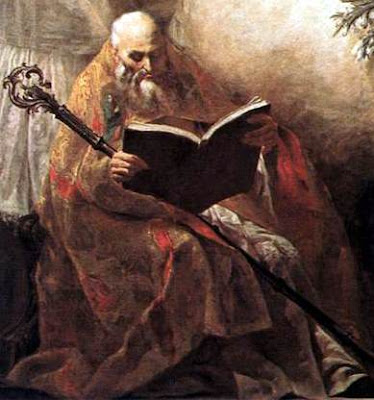St Anthony, abbot (251–356)
Antonius, reputed as amongst the earliest of anchorets, and commonly called the Patriarch of Monks, was a native of Egypt, born about the year 251. After leading an ascetic life for some time in his native village, he withdrew from human society and took up his abode in a cave. His abstinence, his self-inflicted punishments, the temptations of the evil one, the assaults of diomons, and the efficacy of his prayers, are all narrated by St. Athanasius. His manner of life was imitated by a great number of persons, who occasionally resorted to him for advice and instruction. Antonius seems indeed to have been the founder of the solitary mode of living, which soon extended from Egypt into other countries. During the persecution under Maximinus, about the year 310, some of the solitaries were seized in the wilderness, and suffered martyrdom at Alexandria, whither Antonius accompanied them, but was not subjected to punishment. After his return, he retired farther into the desert, but went on one occasion to Alexandria in order to preach against the Arians.
The two monastic orders of St. Anthony originated long after the time of the saint,—one in Dauphine, in the eleventh century; and the other, a military order, in Hainault, in the fourteenth century. In Dauphine, the people were cured of the erysipelas, by the aid, as they thought, of St. Anthony; and the disease was afterwards called St. Anthony’s Fire.
It is scarcely necessary to remark that St. Anthony is one of the most notable of all the saints in the Romish calendar. One cannot travel anywhere in Europe at the present day, and particularly in Italy, without finding, in churches and monasteries, and the habits and familiar ideas of the people, abundant memorials of this early Egyptian anchorite. Even in Scotland, at Leith, a street reveals by its name where a monastery of St. Anthony once stood; while, on the hill of Arthur’s Seat, overhanging Edinburgh, we still see a fragment of a small church that had been dedicated to him, and a fountain called St. Anton’s Well.
The Temptations of St. Anthony have, through St. Athanasius’s memoir, become one of the most familiar of European ideas. Scores of artists from Salvator Rosa downwards, have exerted their talents in depicting these mystic occurrences. Satan, we are informed, first tried, by befuddling his thoughts, to divert him from the design of becoming a monk. Then he appeared to him in the form successively of a handsome woman and a black boy, but without in the least disturbing him. Angry at the defeat, Satan and a multitude of attendant fiends fell upon him during the night, and he was found in his cell in the morning lying to all appearance dead. On another occasion, they expressed their rage by making such a dreadful noise that the walls of his cell shook. ‘They transformed themselves into shapes of all sorts of beasts, lions, bears, leopards, bulls, serpents, asps, scorpions, and wolves; every one of which moved and acted agreeably to the creatures which they represented: the lion roaring and seeming to make towards him; the bull to butt; the serpent to creep; and the wolf to run at him, and so, in short, all the rest; so that Anthony was tortured and mangled by them so grievously that his bodily pain was greater than before.’ But, as it were laughingly, he taunted them, and the devils gnashed their teeth. This continued till the roof of his cell opened, a beam of light shot down, the devils became speechless, Anthony’s pain ceased, and the roof closed again.

Bishop Latimer relates a ‘pretty story’ of St. Anthony, ‘who, being in the wilderness, had there a very hard and strait life, insomuch that none at that time did the like; to whom came a voice from heaven, saying, “Anthony, thou art not so perfect as is a cobbler that dwelleth at Alexandria.” Anthony, hearing this, rose up forthwith and took his staff and went till he came to Alexandria, where he found the cobbler. The cobbler was astonished to see so reverend a father come to his house; when Anthony said unto him, “Come and tell me thy whole conversation, and how thou spendest thy tune.” “Sir,” said the cobbler, “as for me, good works have I none, for my life is but simple and. slender; I am but a poor cobbler. In the morning when I rise, I pray for the whole city wherein I dwell, especially for all such neighbours and poor friends as I have: after I set me at my labour, where I spend the whole day in getting my living; and I keep me from all falsehood, for I hate nothing so much as I do deceitfulness; wherefore, when I make to any man a promise, I keep to it, and perform it truly. And thus I spend my time poorly with my wife and children, whom I teach and instruct, as far as my wit will serve me, to fear and dread God. And this is the sum of my simple life.” In this story, you see how God loveth those who follow their vocation and live uprightly without any falsehood in their dealing. Anthony was a great holy man; yet this cobbler was as much esteemed before God as he.’
Source: hanscomfamily.com

